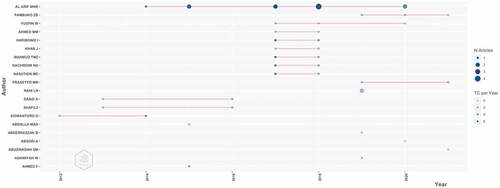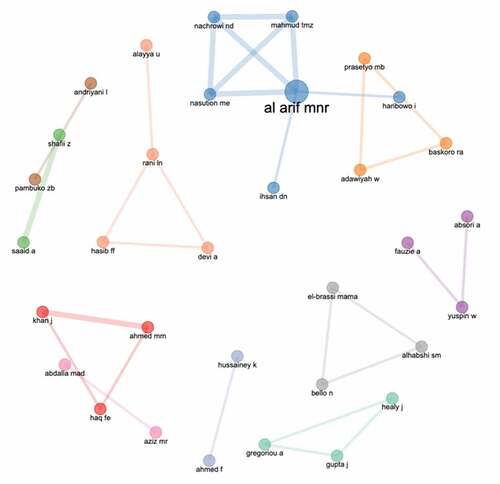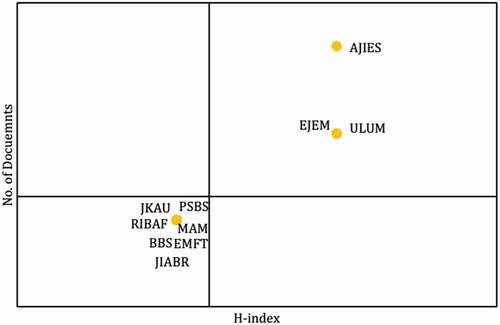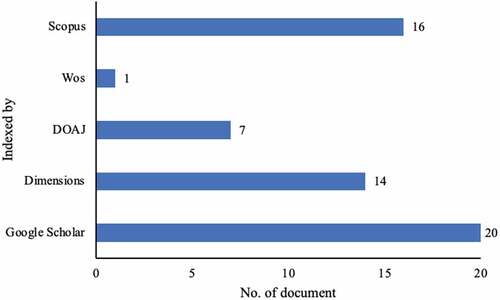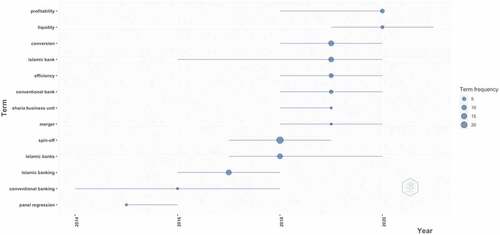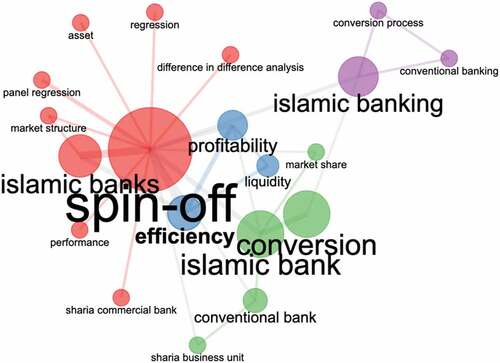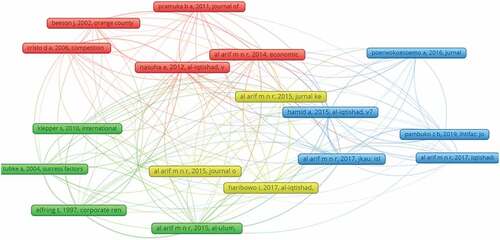Abstract
The purpose of this study was mapping the future research path by determining the progress of literature on spin-off decisions in Islamic banking from 1:2012 to 5:2022. The analysis, however, was limited to the author, source, and keywords. Scopus, Dimensions, and Google Scholar are some of the databases utilized for this bibliometric analysis. The inclusion criteria were English articles on spin-off decision in Islamic banking in the form of journal articles and proceeding papers. Biblioshiny R-package and VOSviewer software were used to analyze a total of 63 publications. Our investigation indicates that studies focusing on spin-off decisions in Islamic banking grew at a 23.08 percent annual rate during the years of observation. This study involved 117 authors where MNR Al Arif from UIN Syarif Hidayatullah Jakarta was a prolific author with 11 publications (h-index 8). Furthermore, when compared to other journals, Al-Iqtishad: Jurnal Ilmu Ekonomi Syariah publishes the most papers. The study of spin-offs is most popularly studied in Indonesia, considering that those are the main development strategy for Islamic banking. Popular keywords in this topic relate to banking performance, such as profitability, liquidity and efficiency. As a result, researchers are focusing their efforts on determining the impact of spin-offs on the performance of Islamic banks although there is no consensus so far. The investigation also provides an overview of the future agenda.
PUBLIC INTEREST STATEMENT
Islamic banks are expanding rapidly not only in the Muslim majority countries but all over the world. One of the development strategies used is by doing a spin-off decision. It changes the business units from the conventional banks to the full-fledged Islamic banks by having a pure spin-offs, conversions, or mergers method. This study conducted using bibliometric analysis to provide an overview of the spin-off decisions in Islamic banks from the existing literature. The analysis was reviewed from the aspects of the prolific author, the institution, the reference sources, and the most discussed topic. This study shows that the previous research more concerned about how the spin-off decision would affect the Islamic banks’ performance. However, the other concerns in the risk of bankruptcy, sharia compliance, and the motives of Islamic banks directors were still neglected. As such, this study suggests the future researchers to explore more on the three other concerns.
1. Introduction
The spin-off becomes a prominent concern when it comes to organizational development, especially as it concerns entrepreneurship, innovation, and management. In a corporate spin-off, a company separates its subsidiary. Existing shareholders in the parent firm receive pro rata shares in the subsidiary company (Chai et al., Citation2018). Many practices, such as university spin-offs (Fuster et al., Citation2019; Mathisen & Rasmussen, Citation2019), companies spin-offs (Buenstorf & Costa, Citation2018; Chai et al., Citation2018), employee spin-offs (Vaznyte et al., Citation2021), and banking spin-offs (Al Arif, Mufraini, et al., Citation2020; Murray, Citation2008; Trinugroho et al., Citation2021), have been implemented. In the context of the banking industry, particularly in Islamic banking, this approach is one of the most important ways for enhancing competitiveness. Moreover, several models are being used in its development. First, a pure spin-off in which traditional banks provide separate Islamic business unit. Second, traditional banks fully converted to Islamic banks. Third, establishing a new full-fledged Islamic bank through the acquisition of a small traditional bank (Alani & Yaacob, Citation2012; M. M. Ahmed & Khan, Citation2017; Suzuki et al., Citation2020).
Furthermore, any decision taken within an economic entity must consider the legislation and laws that regulate the entity’s strategic objectives (Abdalla et al., Citation2015). At the beginning of its development, the mechanism, procedure, and treatment connected to the conversion from conventional banking to Islamic banking were regulated in AAOIFI Shariah standard number 6 in 2002 (Saaid & Shafii, Citation2013). Following that, other Muslim countries issued special regulations on it, including Indonesia’s Law No. 21 of 2008 (Yuspin & Fauzie, Citation2018), Libya’s Law No. 1 of 2013 (El-Brassi et al., Citation2018), and Pakistan’s SBP-IBD Circular No. 1 of 2003 (M. M. Ahmed & Khan, Citation2017). The regulation was put in place for numerous reasons, including (a) speeding the growth of the Islamic banking industry, (b) boosting Islamic banks’ performance, (c) increasing Islamic banks’ independence, and (d) ensuring Sharia compliance (Pambuko et al., Citation2019). Siswantoro (Citation2014), on the other hand, claims that an Islamic windows spin-off from their parent conventional bank can provide various benefits, including improved financial performance, expansion, financial structure realignment, and autonomous management.
According to historical records, the first time a traditional bank converted to an Islamic bank was in Pakistan in 2003 (M. M. Ahmed & Khan, Citation2017). Bangladesh (2004), Bahrain (2007), Indonesia (2008), and Kuwait (2010) followed (Hasan, Citation2016; Pambuko & Pramesti, Citation2020). Several researchers have attempted to explain the motivation behind the spin-off decision, particularly from the standpoint of Islamic bank management, based on this massive movement. The result was found to have three main motives: jurisprudential reasons, such as Islamic inclusivity and usury prohibition; economic reasons, such as Islamic banking being more profitable than traditional banking and increased demand for Islamic banking; and political reasons (Al-Harbi, Citation2020; F. Ahmed & Hussainey, Citation2015; Saaid & Shafii, Citation2013; Suzuki et al., Citation2020).
The spin-off policy, however, is still being evaluated and not yet ready to be applied to all Islamic business units, owing to a decline in financial performance (Al Arif et al., Citation2017; Haribowo, Citation2017; Pambuko, Citation2019). According to other studies, the spin-off policy has no effect on asset growth, financing growth, or profitability (Al Arif, Citation2015b, b; Sihombing & Yahya, Citation2016; Al Arif & Dewanti, Citation2017). The spin-off approach also lowers Islamic banking’s market share (Al Arif, Citation2017). Additionally, efficiency dropped after the spin-off (Al Arif, Haribowo, et al., Citation2018). Other research, however, have produced contrasting results, showing that the spin-off policy raises profitability (Hamid, Citation2015) and the third party funds (Al Arif, Citation2014, Citation2018a). This demonstrates erratic results, making it difficult to determine whether the spin-off was successful. Aside from that, increasing research on spin-offs necessitates a more in-depth investigation so that study accomplishments can be identified. Furthermore, the general study of Islamic economics and finance has grown rapidly, attracting the attention of researchers in conducting bibliometric mapping. Tijjani et al. (Citation2020) examined the development of research in Islamic finance literature from 1939 to 2019 using the Web of Science (WOS) database. Then, research trends in fiqh on finance (Rusydiana et al., Citation2021), Islamic banks in Indonesia (Marlina et al., Citation2021), Islamic microfinance (Srisusilawati et al., Citation2021), Islamic economics and finance by Indonesian authors (Handoko, Citation2020), and COVID-19 and Islamic finance (Rusydiana, Citation2021).
Unlike earlier studies, this one focuses on bibliometric mapping on a specific issue, the Islamic banking spin-off decision. Based on our knowledge, this review has never been done before. Therefore, this study investigated the progress research on spin-off decision in Islamic banking using bibliometric analysis. Bibliometrics is an effective method that offers dataset to policymakers and researchers while also improving research quality (Al Husaeni & Nandiyanto, Citation2022). The findings of this study will provide academics and researchers a comprehensive literature summary on spin-off decisions in Islamic Banking. The analyses will serve as the primary reference for identifying researchers interested in the study of spin-offs in Islamic banking, journals concerned with the issue, and the most widely discussed topics.
2. Research methodology
On the topic of spin-off decisions in Islamic banking, this study used bibliometric mapping. A set of systematic stages were done in elaboration of this study. First, creating a list of research questions to limit the search and focus the efforts. Then conducting a search in three databases, namely Scopus, Dimensions.ai, and Google Scholar, using specific keywords. We also established our own database with the metadata we’ve obtained, which will be utilized for analysis.
2.1. Research questions
We designed research questions to aid in determining the number of articles required to analyze current and future trends. The following are some of the research questions:
Q1: Based on the number of citations, which article has the most influence on the topic and who is the most influential author?
Q2: What are the most significant and linked countries and institutions?
Q3: What are the most developed study topics?
2.2. Data and criteria
Article searches were carried out on three large databases that were accessible for free by researchers, namely Scopus, Dimension.ai, and Google scholar. Scopus was chosen due of the high quality of the papers it indexes (Baas et al., Citation2020). Dimension.ai is a new database with similar journal article coverage to Scopus and citations that are substantially associated with Scopus. Dimensions.ai also indexes articles and citations with a DOI (Thelwall, Citation2018). Meanwhile, Google Scholar is the world’s largest article database, but it has flaws such as a lack of control over the papers indexed (Gusenbauer, Citation2019). We use the Application Programming Interface via Publish and Perish to extract data. The keywords included “spin-off OR conversion AND bank OR banking”, “spin-off OR conversion AND Islamic bank OR Islamic banking”, and “spin-off OR conversion AND sharia bank OR sharia banking.” As a consequence, between 01:2012 and 05:2022, 464 publications in the form of journals, conferences, books, working papers, theses, and citations were collected. The criteria for searching and selecting articles across the three databases summarized in Table .
Table 1. Criteria for data collection and selection
We determined three indicators in the selection of articles. The first consideration is the type of publication. The study relied on peer-reviewed journal articles and conference papers on related themes. Second, language. We only elaborated the articles in English because the practice of spin-offs has become a global concern. Finally, topic relevance. The majority of the articles that were left off the list have little to do with Islamic banking, particularly the practice of spin-offs or conversions from traditional to Islamic banking. We also eliminated duplication as well as non-full text articles because the three databases have some metadata commonalities. This stage included 63 papers for further analysis.
2.3. Data analysis
We performed network and co-citation analyses, as well as research trends, after extracting and processing the data. The Biblioshiny R-package software, a software that provides a set of tools for science mapping analysis, was used to do the network analysis (Aria & Cuccurullo, Citation2017). There were three elements to the network study: (1) word and keyword analysis, (2) scientific collaboration mapping, and (3) top authors, sources, and institution. VOSviewer provides functionality for co-citation analysis (van & Waltman, Citation2021).
3. Results and Discussion
3.1. General information
In 2012, the first literature on the spin-off in Islamic banking appeared. As a result, we restricted our search to articles published between 2012 and 2022. Table summarized the data set based on Scopus, Dimensions, and Google Scholar databases, and serves as a starting point for analysis. There were 63 articles in 58 sources, with an annual average of 3.97 articles. The documents consisted of 57 journal articles (90.48%) and six proceeding papers. 117 authors have contributed to the literature on Islamic banking spin-off decision, with 103 (88.03%) publishing multi-authored papers. Similarly, the number of co-authors per document was greater than two, and the collaboration index is 2.4, indicating that scholars are increasingly collaborating on the issue of spin-offs in Islamic banking. This backed up Wuchty et al. (Citation2007) argument that the bulk of social research written by two authors. In addition, the authors employed 170 keywords and 1004 references in all selected articles. In 11 years of discussion on this topic, the average number of papers published every year has been close to four, with an average citation per document of close to eight and a citation per year per document of 1.28.
Table 2. Data synthesis and summary of the dataset
3.2. Publication and citation trend
The first article on spin-offs in Islamic banking, based on three databases, was conducted by Alani and Yaacob (Citation2012) in the form of an empirical survey on the motive for converting traditional banking to Islamic banking. Figure shows historical statistics for published articles, as well as the average total citations per article and per year, showing that published articles increased by 23.08% annually. The authors’ attention began to appear in 2015 (6 publications) and continue to expand until 2021. With 12 papers published in 2020, it was the year with the most published papers on topics.
Figure 1. Trend of publication (left axis) and citations (right axis) between 01:2012 and 12:2022Footnote1.
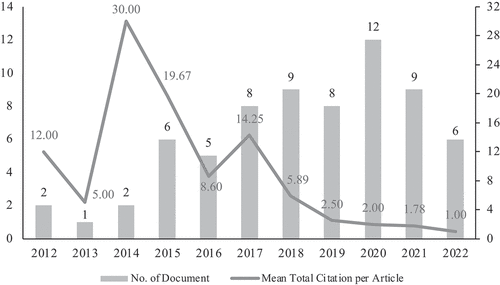
Indonesia, as one of the first countries to set a comprehensive policy regulating the obligatory spin-off for Islamic windows since 2008, conducted the first study on the topic in 2012. One possible explanation for this was that it took around four years to examine the actual effects of Islamic banks’ spin-off decisions, particularly in terms of performance (Trinugroho et al., Citation2021). The mean annual total citations peaked in 2014 and has been fluctuating with a declining trend since then. This might be because later documents did not contribute or were not used as a reference in the subsequent publication. To put it another way, the research gap was growing without taking into consideration the most current findings of earlier studies.
3.3. Author impact
As previously stated, 117 authors contributed to a study on Islamic banking spin-offs. The 20 most prolific authors were listed in Table . Total cited articles, total citations, h-index, g-index, m-index, and impact start year were all used to determine their productivity. The most prolific author was MNR Al Arif, a professor from Islamic State University Syarif Hidayatullah Jakarta, Indonesia, who got the highest score in all aspects. On this topic, he first made an impact in 2014 and currently has h-index 8, g-index 11, m-index 0.889, and 164 citations from 11 articles. D Siswantoro, ZB Pambuko, and MM Ahmed came in second, third, and fourth, respectively. Their difference was in the m-index and total citations, although having the same h-index, g-index, and cited articles. D Siswantoro had the most citations (28 > 7 > 4), and ZB Pambuko had the highest m-index (0.5 > 0.333 > 0.182).
Table 3. Author impact
Figure shows the top-author’s production over time, complementing the information in Table . The publication length indicated by the red line, and the number of articles published indicated by the blue circle. MNR Al Arif, as previously stated, was the most productive author, having contributed for seven years (2014–2020), with 2018 being his most productive year with four articles (Al Arif, Citation2018b, a; Al Arif, Nachrowi, et al., Citation2018, a). He particularly interested in the study of impact of the spin-off decision on Islamic bank performance. Following that, Pambuko (Citation2019-2021) and W Yuspin (2017–2020) each published three papers as first author or corresponding author. Their most recent paper discussed the profitability growth of Islamic banking after spin-off decision (Nurkarim et al., Citation2021). W Yuspin, on the other hand, was in second position based on the length of contributions, having contributed for four years (2017–2020). With two articles each, A Saaid and Z Shafii were next in line with the same contribution period (2013–2016).
3.4. Institutions, countries, and authors’ collaboration network
Based on the number of publications and total citations, Table displays the top 10 institutions and countries that publish about spin-offs in Islamic banking. From 2012 to 2022, Indonesia was the country that contributed the most, with 44 papers (69.84%) and 351 citations. Given that Indonesia established a spin-off policy enabling sharia business units to become full-fledged Islamic banking in 2008, this is logical (Al Arif, Haribowo, et al., Citation2018; Al Arif, Mufraini, et al., Citation2020; Pambuko & Pramesti, Citation2020; Trinugroho et al., Citation2021). The fact that Indonesia has six of the top ten institutions backs this up. With 14 papers and 234 citations, UIN Syarif Hidayatullah Jakarta came in first. Universitas Indonesia (6 papers and 35 citations) came in second, followed by Universitas Airlangga (8 citations), Universitas Muhammadiyah Magelang (7 citations), and Universitas Muhammadiyah Surakarta (6 citations), each by three articles. These five universities have the centers of Islamic economics and finance; therefore, they provide a substantial contribution to the topic. With 5 articles, Indonesia was followed by Malaysia (34 citations) and Pakistan (30 citations). As Islamic banking is a financial institution based on Islamic jurisprudence (Ramazanova et al., Citation2022), this topic is mostly explored in OIC countries. However, the study of conversion or spin-off in Islamic banking has also attracted the attention of other researchers, such as those from the United Kingdom (2 articles) and Japan (1 article).
Table 4. Prolific institution and countries
From a total of 117 authors, the collaboration networks analysis has selected authors who had at least one collaborative publication. Based on the minimal threshold, there were 26 authors in the literature, grouped into 11 clusters with 30 links (Figure ). Cluster 1 (blue) contains MNR Al Arif, I Haribowo, TMZ Mahmud, ME Nasution, EP Dewanti, and DN Ihsan, all from Indonesians. Their major interest was determining the impact of spin-off decisions on Islamic bank performance. Efficiency (Al Arif, Haribowo, et al., Citation2018; Al Arif, Mufraini, et al., Citation2020) and evaluation of spin-off criteria (Al Arif et al., Citation2017; Al Arif, Citation2018b) were two of them. They also provided a number of spin-off models to help Islamic banks grow faster (Al Arif, Masruroh, et al., Citation2020). With 5 links and 5 papers, MNR Al Arif became the most prolific and contributing author in this cluster, confirming the prior argument.
Cluster 2 (neon orange) contains LN Rani, FF Hasib, A Dewi, and U Alayya. Their focus was on the efficiency level after the spin-off with data envelopment analysis (Alayya & Rani, Citation2019; Rusydiana et al., Citation2019). With two papers and three links, LN Rani was the most influential author in this cluster. Cluster 3 (red) is a two-publication collaboration between two Pakistani authors, MM Ahmed and J Khan. They concentrate on the challenge of converting traditional branches to full-fledged Islamic banking (M. M. Ahmed & Khan, Citation2017; M. M. Ahmed et al., Citation2018). Cluster 4 (green) was a collaboration of Malaysian authors, Z Shafii and A Saaid with two publications. They looked at the challenges and motives for converting to Islamic banking, particularly from bankers’ perspective (Saaid & Shafii, Citation2013; Shafii et al., Citation2016).
3.5. Author’s citation analysis
Table presents the top ten most impactful papers in the Islamic banking spin-off analysis. MNR Al Arif was the most well-known author in this topic, with four papers (Al Arif, Citation2014, Citation2015a, a; Al Arif et al., Citation2017). For this analysis, Hamid (Citation2015) was the most prolific author, with 37 citations and average annual citations is almost 5. According to sources, Al-Iqtishad: Jurnal Ilmu Ekonomi Syariah was one of the major sources for Islamic banking spin-off research, with three publications on the list. Haribowo’s (Citation2017), in particular, was a recent publication with the greatest average number of citations per year (5.17) in the top ten list. However, study Trinugroho et al. (Citation2021) published by Research in International Business and Finance (Cite score 4.9 and impact factor 4.091) has the greatest average citation, which was 6.50.
Table 5. Most cited papers
In addition, we presented some key conclusions from the top 10 papers in chronological order. The bulk of articles explored the influence of the spin-off decision on Islamic bank performance. While the remainder focused on the motives and challenges of the conversion decision.
Hamid (Citation2015) argued that spin-offs help Islamic banks become more profitable, hence spin-off attempts should be promoted.
Al Arif (Citation2014) argued that the spin-off policy has a good impact on the growth of third party funds in the Indonesian Islamic banking industry.
Haribowo (Citation2017) documented that Islamic business units of Indonesian regional development banks are having problems attaining the asset threshold of 50% of their parent banks by the end of 2023, which was a criterion for a spin-off under Law 21 2008.
Al Arif (Citation2015a) revealed that the spin-off decision has no impact on the growth of Islamic bank financing.
Al Arif et al. (Citation2017) argued that the spin-off policy has no impact on the performance of Islamic banks, especially at the level of savings and assets.
Siswantoro (Citation2014) documented that Islamic banks resulting from the spin-off must optimize capital injection and temporary deposits. Murabahah was also still dominant as a financing model because of its fixed income and low risk.
Miftah and Wibowo (Citation2017) documented that merger policy was superior than segregation policy in terms of boosting Islamic bank capital.
Alani and Yaacob (Citation2012) revealed that religion is the main motivation in conversion to Islamic banks. In addition, it was also caused by low risk and high profit.
Rafay and Sadiq (Citation2015) argued that the problems faced by conversion were the lack of understanding of stakeholders, the existence of different schools of thought in Islam, and ineffective regulations. This resulted in the absence of a comprehensive framework to support the conversion of conventional banks to Islamic banking.
Al Arif (Citation2015b) revealed that there was no significant asset growth in Islamic banks after the spin-off decision
3.6. Sources impact
Number of citations, number of publications, g-index, h-index, and m-index, were all used in bibliometric analysis for sources impact, just as they were in author impact measurement. There were 63 articles which distributed on 58 publishers. This indicated that there were no journals or scientific conference events dedicated to discussing this topic on a worldwide basis. Figure shows a quadrant analysis of the top ten sources, based on the number of publications and h-index.
The top right quadrant has three sources with a larger number of publications and h-index. With three publications, an h-index of two, and 70 citations, Al-Iqtishad: Jurnal Ilmu Ekonomi Syariah (AJIES) was at the top of the list. AJIES was a DOAJ-indexed journal produced by UIN Syarif Hidayatullah Jakarta. According to the AJIES h-index value, there were two papers, each of which has been cited at least twice. With a score of 3, AJIES has the highest g-index value. It signified that among other journals, AJIES has the fastest growing h-index. The Economic Journal of Emerging Markets (EJEM) (2 publications, h-index 2, g-index 2, and 38 citations) and Al-Ulum (ULUM) (2 publications, h-index 2, g-index 2, and 30 citations) were the next in order in the same quadrant. EJEM was indexed to web of science, while ULUM was indexed by DOAJ.
The smaller number of articles and h-index were displayed in the next quadrant, which was placed at the bottom left. Sources in this quadrant consist of Journal of King Abdulaziz University, Islamic Economics (JKAU; 27 citations), Procedia—Social and Behavioral Sciences (PSBS; 24 citations), Research in International Business and Finance (RIBAF; 13 citations), Management and Marketing (MAM, 13 citations), Banks and Bank Systems (BBS, 12 citations), Emerging Markets Finance and Trade (EMFT; 9 citations) and Journal of Islamic Accounting and Business Research (JIABR; 3 citations). Interestingly, all sources in this quadrant were Scopus indexed journals. According to the m-index, RIBAF was the best of the seven publishers, with a score of 0.5.
Based on publisher quality, of 58 journals, Figure shows that 16 journals (27.58%) were indexed by Scopus. Three of these, namely the Journal of International Financial Markets, Institutions, and Money (SJR 1.317), Research in International Business and Finance (SJR 0.767), and Emerging Markets Finance and Trade (SJR 0.537), are in Quartile 1 (Q1). 1 journal was published by Web of Science and 7 journals were indexed by Directory Open Access Journal (DOAJ). Furthermore, Dimensions indexes 14 journals that were not indexed by Scopus, Web of Science, or DOAJ since they contained an active DOI Crossref. The other 20 journals were only indexed by Google Scholar since they did not meet the preceding four criteria.
3.7. Keywords analysis
The authors’ keywords analysis, according to Song et al. (Citation2019), was an effective instrument for swiftly exploring trending issues. Table displays the most often used keywords in articles about Islamic banking spin-offs. The keyword “spin-off” ranks first among the 170 author’s keywords, with 24 occurrences. This means that this word was used to refer to a concept in the literature. “Conversion,” “Islamic banking,” and “Islamic banks,” all of which had 12 occurrences, follow. In addition, depending on the author’s keywords, time period, and frequency, the analysis in Figure also indicated trend topics. “Conventional banking” and “Islamic banking” were topics that persisted five years, 2014–2018 and 2016–2020, respectively. “Conversion,” “efficiency,” “conventional bank,” “merger,” and “profitability” were the most popular themes in 2018–2020. Furthermore, the most popular topics from 2019 to 2021 were “liquidity.”
Table 6. Top 10–Most frequent keywords
The co-occurrence network of author keywords shown in Figure . A total of 170 keywords were filtered with a minimum of two appearances, and 20 of them met the requirements. The size of the nodes and words indicate the weights of each term, with bigger size suggesting a greater weight. The strength of a link reflected in the distance between nodes. A stronger relationship indicated by a shorter span. The presence of a connection between two terms showed that they appeared together, and the thickness of the link indicates how frequently they appeared together. The node “spin-off” was connected to “Islamic banking” (12), “Islamic bank” (11), “efficiency” (7), “profitability” (6), “conversion” (12), “Islamic banks” (12), and “conventional banks” (5) by thick lines. A cluster formed by nodes of the same color, and the keywords network was separated into four clusters. The term “spin-off” appears in Cluster 1 along with keywords of the same hue. The terms “efficiency,” “conversion,” and “Islamic banking,” in that order, represent Clusters 2–4. Given the evidence, it appeared that the researchers were more interested in investigating the effect of the spin-off phenomena on Islamic banking performance, such as profitability, efficiency, and liquidity.
3.8. Co-citation network
The co-citation of references analysis was frequently used to depict literature mapping, one of it on Islamic banking spin-off. The frequency with which two documents cited jointly by a third document was examined in this map (Small, Citation1973). With the fractional counting approach, the criterion was the number of citations from the cited references is 5 times. As a consequence, 18 of the 1005 references to Islamic banking spin-offs met the threshold. Figure showed four clusters with a total link strength of 70 and 141 links between articles. Each node was a reference, and the size of the node denotes the number of times it has been cited. A co-citation relationship was defined as a link between two nodes, where the stronger the link, the thicker the link. Furthermore, the study topic’s resemblance shown by nodes of the same color.
All of the references that emerge support the preceding findings by emphasizing empirical research on the influence of spin-off decisions on the performance of Islamic banks. The first cluster (red) was made up of five cited papers. Three empirical studies on Islamic banks are cited in this section, including the influence of spin-offs on third-party funds (Al Arif, Citation2014), efficiency (Pramuka, Citation2011), and nine financial performance indicators (Nasuha, Citation2012). Meanwhile, Cristo and Falk (Citation2006) and Beeson and Hyden (Citation2002) addressed the elements influenced the success of a company’s spin-off. Second, Cluster 2 (green) has five referenced publications as well. This cluster included references to corporate spin-off basics such success factors (Tübke, Citation2004), reasons for spin-off decisions (Klepper & Thompson, Citation2010), and organizational economic views on spin-offs in corporate renewal (Elfring & Foss, Citation1997). This cluster also included empirical research on Islamic banks, including the influence of spin-offs on financing growth (Al Arif, Citation2015a) and the necessity for capital injection following a spin-off (Siswantoro, Citation2014).
Third, Cluster 3 (blue) has five cited papers. This cluster was unique in that it solely contains empirical research on spin-offs. From its impact on profitability (Al Arif & Dewanti, Citation2017; Hamid, Citation2015), assets, deposits, and financing, (Al Arif et al., Citation2017), to efficiency (Pambuko, Citation2019). Furthermore, Poerwokoesoemo (Citation2016) examined the impact of spin-offs on the parent conventional bank using five financial variables. Last but not least, not much different, Cluster 4 (yellow) has three cited papers, all of which were empirical studies on the impact of spin-offs on Islamic banks. Al Arif (Citation2015b) looked at its impact on asset growth and Al Arif (Citation2015c) on efficiency. Moreover, Haribowo (Citation2017) predicted whether Islamic banks in Indonesia would be ready to undertake spin-offs in compliance with laws.
4. Opportunities for Future Research
This study has potential as a reference for future literature reviews and provides new insights for further research with its limitations. In our present study, the available literatures pay attention to the term “performance” so that the evaluation of spin-off decisions is more focused on the performance of Islamic banks. As previously stated, the impact of the spin-off is juxtaposed with several indicators such as profitability (Al Arif & Dewanti, Citation2017; Hamid, Citation2015); assets, deposits, and financing (Al Arif, Citation2014, Citation2015a, a; Al Arif et al., Citation2017); and efficiency (Al Arif, Citation2015c; Pambuko, Citation2019; Pramuka, Citation2011). Although inconsistencies were found in the spin-off decisions effect on the performance of Islamic banks, there were three points neglected. First, there is the risk of bankruptcy after spin-off decision. A more in-depth study is needed regarding forecasting the of performance of Islamic banking after the spin-off decision, especially in avoiding potential bankruptcy in the future. Researchers can measure bankruptcy using the Altman Z-Score model (Čihák & Hesse, Citation2010), Banking Stability Index (BSI) (Ghosh, Citation2011), etc.
Second, sharia compliance to purify business processes and separate management from traditional banking was the main reason for spin-off decision although it has not been investigated before. Sharia compliance can be a blatant differentiator because, according to numerous studies, there is no discernible difference between traditional and Islamic banking (Farooq, Citation2012; M. O. Mohammed et al., Citation2008). As Islam also teaches to avoid the usury in financial transactions to prevent wealth from accumulating in a few groups (Ayub, Citation2008; F. Ahmed & Hussainey, Citation2015). Full-fledged Islamic banks are thought to better ensure the purity of their sharia-compliant products and services, just as customers will be happier with an Islamic bank that stands as an independent entity (Trinugroho et al., Citation2021). Therefore, it is crucial to investigate the relationship between the decision of sharia business unit to spin-off and sharia compliance. The Shari’ah Conformity Model (Kuppusamy et al., Citation2010), Maqāṣid al-Sharī‘ah Index (Alhammadi et al., Citation2020; Hudaefi & Noordin, Citation2019), and Maqasid al-Shari’ah Framework (M. Mohammed & Taib, Citation2015; M. O. Mohammed et al., Citation2008) are a few metrics that can be used to gauge the Sharia compliance.
Third, one of the analyses in this study is keyword identification, allowing for the emergence of further studies on spin-off decisions in the Islamic banking sector. However, a systemic review can be conducted in the future to investigate the empirical effects of the spin-off decision on the performance of Islamic banks. It will enrich the study so that decision-makers have clearer evidence and understanding of the impact of their policy. Lastly, the motives of Islamic banking directors to carry out spin-offs require further investigation of the role of religiosity as a determine predictor. Of course, economic potential is the main driving force (F. Ahmed & Hussainey, Citation2015; Hasan, Citation2016; Shafii et al., Citation2016), as shown by the numerous studies looking at the financial performance of Islamic banks after the spin-off decision. This includes the intention to meet Muslim customers’ needs and attract new Muslim customers (Alani & Yaacob, Citation2012). Therefore, the market signal, an external drive, is what drives the majority of motivations to the spin-off. However, the personal motivation of shareholders and directors is still being questioned, especially related to adherence to Islamic teachings. The study is to clarify their motivation, whether it is due to adherence to Islamic teachings or purely business motives to increase market power and competitive advantage.
5. Conclusion
The spin-off phenomena in Islamic banking have occurred in various countries and has been a matter of concern for the growth of Islamic banking, particularly in Indonesia. This is because Islamic business units must separate from their parent conventional banks or spin-offs within 15 years after the enactment of Law 21 2008. Moreover, a part from boosting the performance of Islamic banks as a whole, compliance with the Sharia aspect is also a critical point. As Islamic banks are more resilient to crises, there is hope that Islamic banks will be able to contribute to socioeconomic growth if they continue to grow. This paper looks at the research progress on spin-offs in Islamic banking using bibliometric mapping analysis.
This study used three databases, Scopus, Dimensions, and Google Scholar, to map the literature on spin-offs in Islamic banking, both in terms of paper, author, sources, institution, and countries. We are the first to write about this subject. The analysis was carried out with Rstudio and VOSviewer software. In May 2022, 63 papers were discovered from 58 sources, including journals and proceeding papers by 117 authors. According to the inclusion criteria, the first publication on Islamic banking spin-off was in 2012 and grew 23.08% per year. The country with the most authors who publish on this topic is Indonesia. Non-majority Muslim countries, such as the United Kingdom and Japan, are also included in the list.
Correspondingly, UIN Syarif Hidayatullah Jakarta, Indonesia has emerged as the most prolific institution committed to this topic. This also makes MNR Al Arif, one of their professors, the most prolific author, with 11 papers published. He focuses on the financial performance condition of Islamic banks after spin-off decision. MNR Al Arif alongside ND Nachrowi, ME Nasution, and TMZ Mahmud have the greatest coupling strength of intellectual impact, based on author collaboration. We also discovered that the DOAJ-indexed journal, Al-Iqtishad: Jurnal Ilmu Ekonomi Syariah (AJIES), is the most influential journal on this topic, with three papers. Then came EJEM and ULUM in the following order. The contribution of AJIES has also resulted in one of its publications becoming the most cited papers, particularly Hamid’s (Citation2015) work. Furthermore, this issue has not become a concern for reputable international journals considering that only 27.58% of them are indexed by Scopus.
This paper serves as a guide for scholars interested in what emerges in Islamic banking spin-off studies. This study has various limitations, despite the fact that it was carried out to the best of its ability. First, it only looks at publications related to Islamic banking spin-off decisions, which are examined based on the authors and sources impact, the most prolific institutions and countries, citations, keywords, and co-citation network analysis, as well as the collaboration network. Other analyzes that can be explored using bibliometrics tools include word cloud, trend topics, co-occurrence network, thematic map, and so on. Second, the data collection is limited to 5 May 2022, it is possible that additional papers will be published in the future, particularly on Scopus, Dimensions, and Google Scholar databases. The scholars can also explore more credible databases, such as the Web of Science. Third, the author only generates journal articles and conference papers. In order to gain a more comprehensive analysis, future researchers might include more categories of publications, such as working papers, theses, dissertations, books, and chapters. Fourth, as we are focusing on English-language publications, we recommend developing search using local languages in countries that implement this policy. Arabic, Indonesian, Malaysian Malay, and Urdu are among them.
Authors’ Contributions
ZBP retrieving literature, conducting data analysis and writing the paper. JS verified the analytical methods, revised the paper and helped to write the manuscript. All authors discussed the results and contributed to the final manuscript.
Disclosure statement
No potential conflict of interest was reported by the authors.
Additional information
Funding
Notes on contributors

Zulfikar Bagus Pambuko
Zulfikar Bagus Pambuko is a lecturer and researcher at the Universitas Muhammadiyah Magelang,Indonesia. He is interested in the study of Islamic economics and finance, particularly its practice in Islamic financial institutions. He has served as a reviewer of several international peer-reviewed journals. He is also an active researcher at the Islamic Philanthropy Study Center (IPSyC), Indonesia. This paper is co-authored by Jaka Sriyana, a Professor of Economics in the Department of Economics, Islamic University of Indonesia, Yogyakarta, Indonesia. He has served as an Editor-in-chief of the Economic Journal of Emerging Markets since 2016. His research experience in Islamic economics, regional development and entrepreneurship, public policy, public finance, energy economics, and innovation & sustainability.
Notes
1. Data analysis was performed on inclusion articles between January 2012 and May 2022. As of May 2022, there were only one article with no citations. However, five articles with six citations (published between June and December 2022) and two articles with no citations (published between January and April 2023) were left out of the analysis.
References
- Abdalla, M. A. D., Aziz, M. R., & Johari, F. (2015). Testing the impact of the central bank’s support for the experience of converting the conventional banks into Islamic in Libya multiple-groups analysis using structural equation modeling. International Journal of Scientific Research, 4(9), 1947–18.
- Ahmed, F., & Hussainey, K. (2015). Conversion into Islamic banks: Jurisprudence, economic and AAOIFI requirements. European Journal of Islamic Finance, (3), 1–8.
- Ahmed, M. M., & Khan, J. (2017). Conversion of conventional banking branches into Islamic banking: The case of Pakistani Banks. Tahdhib Al Afkar, 4(1), 11–16.
- Ahmed, M. M., Khan, J., & e, H. F. (2018). Paradigm shift from conventional to Islamic banking system: A Case of the conversion of Taqwa Islamic Banking in Pakistan. Global Reg Rev, 3(I), 321–332. https://doi.org/10.31703/grr.2018(iii-i).23
- Alani, F. S., & Yaacob, H. (2012). Traditional Banks Conversion Motivation into Islamic Banks: Evidence from the Middle East. International Business Research, 5, 83–98. https://doi.org/10.5539/ibr.v5n12p83
- Al Arif, M. N. R. (2014). Spin-off and its impact on the third party funds of Indonesian Islamic banking industry. Economic Journal of Emerging Markets, 6(1), 50–55. https://doi.org/10.20885/ejem.vol6.iss1.art5
- Al Arif, M. N. R. (2015a). The effect of spin-off policy on financing growth in Indonesian Islamic Banking Industry. Al-Ulum, 15(1), 173–184. https://doi.org/10.30603/au.v15i1.170
- Al Arif, M. N. R. (2015b). Impact of Spin-Off Policy on the Asset Growth on Indonesian Islamic Banking Industry. Journal of Islamic Economics, Banking and Finance, 11(4), 41–52. https://doi.org/10.12816/02024787
- Al Arif, M. N. R. (2015c). Keterkaitan Kebijakan Pemisahan Terhadap Tingkat Efisiensi pada Industri Perbankan Syariah di Indonesia. J Keuang dan Perbank, 19(2), 295–304.
- Al Arif, M. N. R. (2017). Spin-Off and Market Share in the Indonesian Islamic Banking Industry: A Difference in Difference Analysis. Management & Marketing, 12(4), 540–551. https://doi.org/10.1515/mmcks-2017-0032
- Al Arif, M. N. R. (2018a). Does the spin-off policy can accelerate the deposit funds in the Indonesian Islamic Banking Industry? Journal of Business & Retail Management Research, 13(01), 171–178. https://doi.org/10.24052/JBRMR/V13IS01/ART-17
- Al Arif, M. N. R. (2018b). Spin-off, market structure, and deposit funds in an Islamic banking industry. Economic Journal of Emerging Markets, 10(2), 187–193. https://doi.org/10.20885/ejem.vol10.iss2.art7
- Al Arif, M. N. R., & Dewanti, E. P. (2017). Metode Spin-Off dan Tingkat Profitabilitas: Studi pada Bank Umum Syariah Hasil Spin-Off. Iqtishadia J Kaji Ekon dan Bisnis Islam, 10(1), 23–43. https://doi.org/10.21043/iqtishadia.v10i1.2316
- Al Arif, M. N. R., Haribowo, I., & Suherlan, A. (2018). Spin-Off Policy and Efficiency in the Indonesian Islamic Banking Industry. 13(1), 1–10. https://doi.org/10.21511/bbs.13(1).2018.01
- Al Arif, M. N. R., Masruroh, A., Ihsan, D. N., & Rahmawati, Y. (2020). The alternative strategies for accelerating Islamic banking growth: Mergers, Spin-Offs, Acquisitions and Conversions. Al-Ulum, 20(1), 24–37. https://doi.org/10.30603/au.v20i1.1171
- Al Arif, M. N. R., Mufraini, M. A., & Prabowo, M. A. (2020). Market structure, spin-off, and efficiency: Evidence from Indonesian Islamic Banking Industry. Emerg Mark Financ Trade, 56, 329–337. https://doi.org/10.1080/1540496X.2018.1553162
- Al Arif, M. N. R., Nachrowi, N. D., Nasution, M. E., & Mahmud, T. M. Z. (2017). The Islamic Banking Spin-Off: Lessons From Indonesian Islamic Banking Experiences. Journal King Abdulaziz Univ Islam Econ, 30(2), 117–133. https://doi.org/10.4197/Islec.30-2.11
- Al Arif, M. N. R., Nachrowi, N. D., Nasution, M. E., & Mahmud, T. M. Z. (2018). Evaluation of the Spinoffs Criteria: A Lesson from the Indonesian Islamic banking industry. Iqtishadia J Kaji Ekon dan Bisnis Islam, 11(1), 87–104. https://doi.org/10.21043/iqtishadia.v10i2.2863
- Alayya, U., & Rani, L. N. (2019) Intertemporal efficiency analysis of Indonesian sharia commercial bank after spin off period 2013-2017: Data Envelopment Analysis (Window Analysis). Proceedings of the 2nd International Conference on Islamic Economics, Business, and Philanthropy (ICIEBP), Surabaya, Indonesia (pp. 330–345).
- Alhammadi, S., Alotaibi, K. O., & Hakam, D. F. (2020). Analysing Islamic banking ethical performance from Maqāṣid al-Sharī‘ah perspective: Evidence from Indonesia. Journal of Sustainable Finance & Investment, 12(4), 1–23. https://doi.org/10.1080/20430795.2020.1848179
- Al-Harbi, A. (2020). The effect of conversion of conventional banks to Islamic Banks: Evidence from GCC Countries. International Journal of Business and Systems Research, 5(1), 1–35. https://doi.org/10.32890/ijib2020.5.1.1
- Al Husaeni, D. F., & Nandiyanto, A. B. D. (2022). Bibliometric using vosviewer with publish or Perish (using Google Scholar data): From Step-by-step Processing for Users to the Practical Examples in the Analysis of Digital Learning Articles in Pre and Post Covid-19 Pandemic. ASEAN Journal of Science Engineering, 2(1), 19–46.
- Aria, M., & Cuccurullo, C. (2017). Bibliometrix: An R-tool for comprehensive science mapping analysis. Journal of Informetrics, 11(4), 959–975. https://doi.org/10.1016/j.joi.2017.08.007
- Ayub, M. (2008). Understanding Islamic Finance. Wiley.
- Baas, J., Schotten, M., Plume, A., Côté, G., & Karimi, R. (2020). Scopus as a curated, high-quality bibliometric data source for academic research in quantitative science studies. Quantitative Science Studies, 1(1), 377–386. https://doi.org/10.1162/qss_a_00019
- Beeson, J., & Hyden, C. (2002). Corporate spin-offs: Gaining focus and unleashing stockholder value. Orange Journal of Cty Business14, 39, 14–22.
- Buenstorf, G., & Costa, C. (2018). Drivers of spin-off performance in industry clusters: Embodied knowledge or embedded firms? Research Policy, 47(3), 663–673. https://doi.org/10.1016/j.respol.2018.01.015
- Chai, D., Lin, Z., & Veld, C. (2018). Value-creation through spin-offs: Australian evidence. Australian Journal of Management, 43(3), 353–372. https://doi.org/10.1177/0312896217729728
- Čihák, M., & Hesse, H. (2010). Islamic Banks and Financial Stability: An empirical analysis. Journal of Financial Services Research, 38(2–3), 95–113. https://doi.org/10.1007/s10693-010-0089-0
- Cristo, D. A., & Falk, R. W. (2006). Spinoffs and Carveouts: Some Factors Leading to Successful Divestiture. Compet Forum, 4(2), 331–347.
- El-Brassi, M. A. M. A., Bello, N., & Alhabshi, S. M. (2018). Conversion of conventional banks to Islamic banks in Libya: Issues and challenges. International Journal of Accounting, Finance Business, 3(15), 25–39.
- Elfring, T., & Foss, N. J. (1997). Corporate Renewal Through internal venturing and spin-offs: Perspectives from organizational economics. Copenhagen Business School.
- Farooq, M. O. (2012). Exploitation, profit and the riba -interest reductionism. International Journal of Islamic & Middle Eastern Finance & Management, 5(4), 292–320. https://doi.org/10.1108/17538391211282818
- Fuster, E., Padilla-Meléndez, A., Lockett, N., & Del-Águila-Obra, A. R. (2019). The emerging role of university spin-off companies in developing regional entrepreneurial university ecosystems: The case of Andalusia. Technol Forecast Social Change, 141, 219–231. https://doi.org/10.1016/j.techfore.2018.10.020
- Ghosh, S. (2011). A simple index of banking fragility: Application to Indian data. The Journal of Risk Finance, 12(2), 112–120. https://doi.org/10.1108/15265941111112839
- Gusenbauer, M. (2019). Google Scholar to overshadow them all? Comparing the sizes of 12 academic search engines and bibliographic databases. Scientometrics, 118(1), 177–214. https://doi.org/10.1007/s11192-018-2958-5
- Hamid, A. (2015). The Impact of Spin-off Policy to the Profitability on Indonesian Islamic Banking Industry. Al-Iqtishad: Jurnal Ilmu Ekonomi Syariah, 7(1), 117–126. https://doi.org/10.12816/0024787
- Handoko, L. H. (2020). Bibliometric analysis and visualization of Islamic economics and finance articles indexed in Scopus by Indonesian authors. Science Editing, 7(2), 169–176. https://doi.org/10.6087/KCSE.213
- Haribowo, I. (2017). The Indonesian Islamic Bank’s Spin-off: A study in regional development banks. Al-Iqtishad: Journal of Islamic Economics, 9(1), 53–68. https://doi.org/10.15408/aiq.v9i1.4308
- Hasan, Z. (2016). Conversion of conventional banks into Islamic banks: The case of Bangladesh. Int Journal of Ethics Soc Sci, 4(1), 63–78.
- Hudaefi, F. A., & Noordin, K. (2019). Harmonizing and constructing an integrated maqāṣid al-Sharīʿah index for measuring the performance of Islamic banks. ISRA International Journal of Islamic Finance, 11(2), 282–302. https://doi.org/10.1108/IJIF-01-2018-0003
- Klepper, S., & Thompson, P. (2010). Disagreements and intra-industry spinoffs. International Journal of Industrial Organization, 28(5), 526–538. https://doi.org/10.1016/j.ijindorg.2010.01.002
- Kuppusamy, M., Saleh, A. S., & Samudhram, A. (2010). Measurement of Islamic banks performance using a shariah conformity and profitability model. Rev Islam Econ, 13(2), 35–48.
- Marlina, L., Rusydiana, A. S., Hidayat, P., & Firdaus, N. (2021). Twenty Years of Islamic Banking in Indonesia: A Biblioshiny Application. Libr Philos Pract.
- Mathisen, M. T., & Rasmussen, E. (2019). The development, growth, and performance of university spin-offs: A critical review. The Journal of Technology Transfer, 44(6), 1891–1938. https://doi.org/10.1007/s10961-018-09714-9
- Miftah, K., & Wibowo, H. (2017). Merger and Industrial Acceleration: Study at Indonesian Islamic Banking Industry. Signifikan: Jurnal Ilmu Ekonomi, 6(1), 29–48. https://doi.org/10.15408/sjie.v6i1.4728
- Mohammed, M. O., Razak, D. A., & Taib, F. M. (2008). The performance measures of Islamic banking based on the maqasid framework. Proceedings of the 4th IIUM International Accounting Conference (INTAC IV), Sepang Utara, Malaysia (pp. 1–17).
- Mohammed, M., & Taib, F. M. (2015). Developing Islamic banking performance measures based on Maqasid al-Shari’ah framework: Cases of 24 selected banks. Journal of Islamic Monetary Economics and Finance, 1(1), 55–77. https://doi.org/10.21098/jimf.v1i1.483
- Murray, L. (2008). Spin-offs in an environment of bank debt. Journal of Business Finance & Accounting, 35(3–4), 406–433. https://doi.org/10.1111/j.1468-5957.2008.02088.x
- Nasuha, A. (2012). Dampak Kebijakan Spin-off Terhadap Kinerja Bank Syariah. Al-Iqtishad: Journal of Islamic Economics, 4(2), 241–258. https://doi.org/10.15408/aiq.v4i2.2534
- Nurkarim, D. F., Wulandari, A. P., & Pambuko, Z. B. (2021). Spin-Off and Profitability of Indonesian Islamic Banking. Urecol Journal Part B Economics and Business, 1(2), 93–101. https://doi.org/10.53017/ujeb.116
- Pambuko, Z. B. (2019). Kebijakan Spin-off dan Efisiensi Perbankan Syariah di Indonesia. Ihtifaz: Journal of Islamic Economics, Finance, and Banking, 2(1), 21–38. https://doi.org/10.12928/ijiefb.v2i1.822
- Pambuko, Z. B., & Pramesti, D. A. (2020). The Effectiveness of Bank Aceh Syariah Conversion Decisions. Economica: Jurnal Ekonomi Islam, 11(1), 1–23. https://doi.org/10.21580/economica.2020.11.1.3494
- Pambuko, Z. B., Usman, N., & Andriyani, L. (2019). Spin-off and Social Funds’ Productivity of Islamic Banking Industry in Indonesia. Proceedings of the First International Conference on Progressive Civil Society (ICONPROCS 2019). Advances in Social Science, Education and Humanities Research, Atlantis Press, Yogyakarta, (pp. 7–10).
- Poerwokoesoemo, A. (2016). Kinerja Bank Konvensional Pasca Spin Off Unit Usaha Syariah. Jurnal Keuangan dan Perbankan, 12(2), 145–164. https://doi.org/10.35384/jkp.v12i2.24
- Pramuka, B. A. (2011). Assessing profit efficiency of Islamic banks in Indonesia: An Intermediation Approach. Journal of Economics, Business, and Accountancy | Ventura, 14(1), 79–88. https://doi.org/10.14414/jebav.v14i1.21
- Rafay, A., & Sadiq, R. (2015). Problems and issues in transformation from conventional banking to Islamic banking: Literature review for the need of a comprehensive framework for a smooth change. City University Research Journal, 5(2), 315–326.
- Ramazanova, A., Sabitova, A., Orsayeva, R., Bairkenova, G., & Smailova, I. (2022). Financial sector components in a religious context: Judaism, Christianity, and Islam. Journal of Behavioral and Experimental Finance, 34, 100656. https://doi.org/10.1016/j.jbef.2022.100656
- Rusydiana, A. S. (2021). Bibliometric analysis of journals, authors, and topics related to COVID-19 and Islamic finance listed in the Dimensions database by Biblioshiny. Science Editing, 8(1), 72–78. https://doi.org/10.6087/kcse.232
- Rusydiana, A. S., As-Salafiyah, A., Sanrego, Y. D., & Marlina, L. (2021). Fiqh on Finance: A Scientometric Analysis using Bibliometrix. Libr Philos Pract.
- Rusydiana, A. S., Devi, A., Hasib, F. F., & Rani, L. N. (2019). Spin-off Policy of Sharia Bank: Is it Profitable? Al-Iqtishad: Jurnal Ilmu Ekonomi Syariah, 11(2), 265–288. https://doi.org/10.15408/aiq.v11i2.9157
- Saaid, A., & Shafii, Z. (2013). The obstacles facing conversion process from conventional banks to Islamic Banking: A Review of Literature. Proceedings of the 5th Islamic economic system conference 2013, Kuala Lumpur.
- Shafii, Z., Shahimi, S., & Saaid, A. (2016). Obstacles and motivation behind conversion of conventional banks to Islamic banks: An overview. International Review of Managerial Science, 5(3), 1021–1038.
- Sihombing, N. H., & Yahya, M. R. (2016). Pengaruh Kebijakan Spin-Off, Beban Operasional Pendapatan Operasional (BOPO), Dana Pihak Ketiga (DPK), dan Non Performing Financing (NPF) Terhadap Profitabilitas Perbankan Syariah di Indonesia. J Ilm Mhs Ekon Akunt, 1(2), 127–137.
- Siswantoro, D. (2014). Analysis of Islamic bank’s performance and strategy after spin-off as Islamic full-fledged scheme in Indonesia. Procedia - Social & Behavioral Sciences, 164, 41–48. https://doi.org/10.1016/j.sbspro.2014.11.048
- Small, H. (1973). Co-citation in the scientific literature: A new measure of the relationship between two documents. Journal of the American Society for Information Science, 24(4), 265–269. https://doi.org/10.1002/asi.4630240406
- Song, Y., Chen, X., Hao, T., Liu, Z., & Lan, Z. (2019). Exploring two decades of research on classroom dialogue by using bibliometric analysis. Computers & Education, 137, 12–31. https://doi.org/10.1016/j.compedu.2019.04.002
- Srisusilawati, P., Rusydiana, A. S., Sanrego, Y. D., & Tubastuvi, N. (2021). Biblioshiny R Application on Islamic Microfinance Research. Libr Philos Pract.
- Suzuki, Y., Uddin, S. M. S., & AKMR, I. (2020). Incentives for conventional banks for the conversion into Islamic banks: Evidence from Bangladesh. Journal of Islamic Accounting and Business Research, 11(2), 273–287. https://doi.org/10.1108/JIABR-03-2017-0031
- Thelwall, M. (2018). Dimensions: A competitor to Scopus and the Web of Science? Journal of Informetrics, 12(2), 430–435. https://doi.org/10.1016/j.joi.2018.03.006
- Tijjani, B., Ashiq, M., Siddique, N., Khan, M. A., & Rasul, A. (2020). A bibliometric analysis of quality research papers in Islamic finance: Evidence from Web of Science. ISRA International Journal of Islamic Finance, 13(1), 84–101. https://doi.org/10.1108/IJIF-03-2020-0056
- Trinugroho, I., Santoso, W., Irawanto, R., & Pamungkas, P. (2021). Is spin-off policy an effective way to improve performance of Islamic banks? Evidence from Indonesia. Research in International Business and Finance, 56, 101352. https://doi.org/10.1016/j.ribaf.2020.101352
- Tübke, A. (2004). Success Factors of Corporate Spin-Offs. In J. Acs & David B. A. (Eds.), International Studies in Entrepreneurship(pp. 256). Springer-Verlag.
- van, E. N., & Waltman, L. (2021). VOSviewer Manual. Univeristeit Leiden.
- Vaznyte, E., Andries, P., & Demeulemeester, S. (2021). “Don’t leave me this way!” Drivers of parental hostility and employee spin-offs’ performance. Small Business Economics, 57(1), 265–293. https://doi.org/10.1007/s11187-019-00305-y
- Wuchty, S., Jones, B. F., & Uzzi, B. (2007). The increasing dominance of teams in production of knowledge. Science, 80-) 316(5827), 1036–1039. https://doi.org/10.1126/science.1136099
- Yuspin, W., & Fauzie, A. (2018). The effectiveness of spin off as a breakthrough in promoting Islamic Banking in Indonesia. Journal of Social Science Research, 213–216. https://doi.org/10.32861/jssr.spi6.213.216

